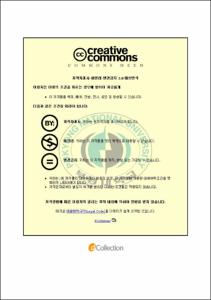서경별곡의 창작배경과 연군가적 성격 연구
- Alternative Title
- A Study on the Background of Origination for and Its Characteristics as Love Song for King
- Abstract
- Goryeo folksong, also known as ‘the gasa of folk music,’ was used as akjang(악장) in Goryeo dynasty, along with A-ak(아악) and Dang-ak(당악). It was not only sung in the royal court of Goryeo, but also handed down to be sung at the royal chamber of Joseon dynasty.
This study came up with questions about which was negatively evaluated in Joseon dynasty as it was one of ‘the lyrics of merry love between man and woman’ and which does not escape the similar notion nowadays, even though it was gasa of royal ceremonial music and sacrificial ritual music in Goryeo, it attempted to examine those questions. Also, the author’s views were asserted based on the about the background of the song’s origination and the group of originators which are not clearly known despite many series of researches done so far.
Text contents are as follows.
First, this study initially set a perspective that since was adapted from the minyo(popular songs) in Seogyeong at that time, it must reflect the unique historical features of that region. Seogyeong of Goryeo was developed by King Taejo as a political power base to check the local powerful clans in early Goryeo dynasty. Therefore, was originated from this historical background, and the separation problem contained in the work was assumed to indicate that the departing subject, who is the king, is situated in the dynamic relation between Seogyeong party and Gaegyeong party.
Based on this assumption, finding a historical context for this work in confirmed that this song was settled during the time from Myochung’s Rebellion in King Injong period to when the revolt was finally calmed down. In King Injong period, externally, Jurchen who once obeyed Goryeo as a parent country grew up to give pressure that Goryeo must submit as a ruled subject, and amongst the internally chaotic situations, the revolt of Yi Ja-Gyum and Chuk Choon-Gyung burned the royal palace, derogated the authority of kingship. King Injong tried to check Gaegyeong party, which overgrew due to Yi Ja-Gyum’s abusive use of power, with the power of Seogyeong party. Afterward, he once collaborated with Myochung and other people from Seogyeong party in an attempt to move the capital, but after he realized their false dreams, he took a different political view and separated from Seogyeong party.
At that time, Myochung made a revolt in Seogyeong, and this revolt causes Seogyeong party to internally disintegrate. It was concluded that was created at this period by Kim Jung-soon, Noh Young-Geo, and other power groups that supported the royal house in Seogyeong party, and they gained enough sympathy from the ordinary people to spread out the song. implies the competition to take the initiative between Seogyeong party and Gaegyeong party who were political stakeholders along with the royal house of Goryeo, and the song describes the life scenes of the people living in Seogyeong as missing and remaining loyal to the king during the process of subduing Myochung’s Rebellion.
Also, after analyzing the song based on the author’s opinion about the background of origination and the group of originators, it was found that it has the characteristics of a love song for ruler in that the content of the lyrics is about the loyalty to the king. That is, the song says that ‘even though he left me, I am ready to follow him leaving everything - precious Seogyeong, my job, etc - behind, and my love and loyalty for him will last forever’, thereby, the lyrics of this song could not be any less satisfactory to the central ruling class.
In addition, the format of love song that uses the female narrator, which appears in other folk songs in royal court music along with , represents the feeling of love and the blessing for the king, and is one of the major features of folk song at that time as an akjang.
Therefore, is one of the lyrics of loyal subjects loving the ruler sung by the mouth of female narrator, along with , and is a significant artwork in the history of literature in that it succeeded to the root, which ranges from to , of the lyrics of loyal subjects loving the ruler.
- Issued Date
- 2007
- Awarded Date
- 2007. 8
- Type
- Dissertation
- Publisher
- 부경대학교 대학원
- Alternative Author(s)
- Lee, Hyeon-Ju
- Affiliation
- 부경대학교 대학원
- Department
- 대학원 국어국문학과
- Advisor
- 김쾌덕
- Table Of Contents
- Ⅰ. 서론 = 1
1. 문제제기 및 연구방법 = 1
2. 연구사 검토 = 5
Ⅱ. 의 창작배경과 작자층 = 12
1. 서경과 왕실과의 관계 = 17
2. 작품의 창작배경과 창작시기 = 26
3. 작품의 작자층 = 42
Ⅲ. 의 연군가적 성격과 문학사적 의의 = 47
1. 작품의 연군가적 성격 = 47
2. 연군가적 성격분석 = 52
1) 이별에 대한 거부와 충성의 호소 = 53
2) 신의와 충성의 강조 = 57
3) 체념과 관심을 호소 = 61
3. 문학사적 의의 = 66
Ⅴ. 결론 = 69
참고문헌 = 72
- Degree
- Master
- Files in This Item:
-
-
Download
 서경별곡의 창작배경과 연군가적 성격 연구.pdf
기타 데이터 / 1.23 MB / Adobe PDF
서경별곡의 창작배경과 연군가적 성격 연구.pdf
기타 데이터 / 1.23 MB / Adobe PDF
-
Items in Repository are protected by copyright, with all rights reserved, unless otherwise indicated.